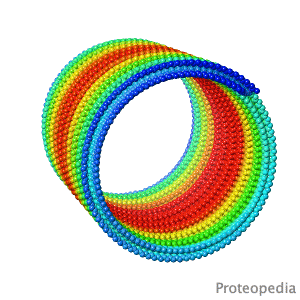Proteopedia:Featured SEL/9
From Proteopedia
(Difference between revisions)
Eric Martz (Talk | contribs)
(New page: <table> <tr><td> <imagemap> Image:Featured-gas-vesicle-7r1c.gif|center default https://proteopedia.org/w/FirstGlance/Virus_Capsids_and_Other_Large_Assemblies#Bacterial_Gas_Vesicle </im...)
Next diff →
Revision as of 23:49, 6 November 2022
Bacteria float with nano-balloons.
ST Huber, D Terwiel, WH Evers, D Maresca, AJ Jakobi. Preprint 2022 doi: 10.1101/2022.05.08.489936 |


